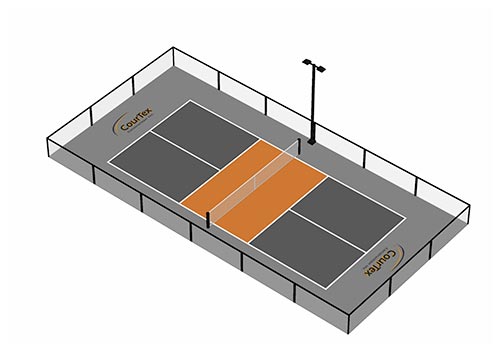Top Quality Pickleball Court Construction for every single Degree of Play
Top Quality Pickleball Court Construction for every single Degree of Play
Blog Article
Sustainable Practices in Pickleball Court Building You Must Know
As the popularity of pickleball continues to climb, so too does the requirement for lasting practices in court construction. The effect of these techniques extends far past the court itself.
Choosing Eco-Friendly Materials
Selecting green materials is a vital step in the construction of sustainable pickleball courts. The selection of sustainable products not just minimizes environmental impact however likewise improves the durability and performance of the court. Key materials include recycled rubber for the surface, which offers exceptional durability and shock absorption while drawing away waste from land fills.
In addition, using in your area sourced products minimizes transportation emissions and sustains regional economic climates. Pickleball court construction. Making use of indigenous hardwoods for fencing and seats can give a lasting visual while making certain resilience against the elements.
Including absorptive materials for court foundations can additionally add to sustainability by permitting natural water drainage and reducing drainage. These selections not just safeguard regional ecological communities however additionally advertise healthier play atmospheres.
Reliable Drainage Solutions
While the choice of eco-friendly products is vital, applying efficient drain remedies is equally crucial for preserving lasting pickleball courts. Appropriate water drainage not only secures the court surface area from water damage however additionally minimizes erosion and runoff, promoting environmental stability.
Efficient drain systems can consist of absorptive paving, which enables water to penetrate the ground instead of pooling externally. This minimizes the chance of standing water, which can bring about mold and mildew and other upkeep problems. Additionally, incorporating strategically positioned water drainage networks and swales can guide excess water away from the court area, guaranteeing a dry having fun surface area and avoiding soil disintegration.
Utilizing indigenous vegetation in the landscaping around the courts can additionally improve drain by taking in excess water and decreasing drainage. These plants need less watering and promote biodiversity, straightening with sustainable techniques.
Additionally, it is essential to on a regular basis maintain the drain system to guarantee its long-term efficiency. This consists of clearing up debris and monitoring for blockages. By focusing on efficient drain services, pickleball court fitters can considerably add to the sustainability and long life of the center, ultimately profiting both gamers and the setting.
Energy-Efficient Lights Options
As the demand for pickleball remains to expand, incorporating energy-efficient lighting choices right into court style has actually come to be increasingly crucial for sustainability. Typical lighting systems frequently take in too much power, adding to greater functional prices and ecological influence. Therefore, adopting modern, energy-efficient technologies is important for both new buildings and remodellings.
LED (Light Emitting Diode) lighting attracts attention as a top choice due to its long life and energy savings (Pickleball court construction). Contrasted to traditional illumination, LEDs make use of around 75% less Your Domain Name power and can last approximately 25 times much longer, substantially lowering maintenance costs. The directional nature of LED lighting reduces light contamination, ensuring that illumination is concentrated on the court instead than surrounding areas.

Lasting Surface Area Alternatives
Exploring lasting surface area choices for pickleball courts has gotten grip amongst gamers and builders alike. The emphasis on environmentally friendly materials not only aligns with the expanding ecological awareness but also enhances the performance and sturdiness of the courts.
This material gives exceptional shock absorption, decreasing the threat of injuries for players while advertising sustainability. These tiles are very easy to replace and mount, and their flexibility permits for various court setups.
Natural yard courts are also emerging as a sustainable option, advertising biodiversity and reducing the heat island impact. Nevertheless, they call for normal maintenance and water, which may not line up with all sustainability goals.

Water Preservation Techniques

One more effective strategy entails the setup of rain harvesting systems. These systems accumulate and store rain for usage in keeping court surface areas and landscape design. This strategy not only saves safe and clean water however likewise minimizes dependence on municipal sources.
Furthermore, employing drought-resistant landscape design around the courts is essential. Indigenous plants require much less water and are better adjusted to regional environment problems, thus lowering overall water consumption. In addition, making use of reliable irrigation systems, such as drip irrigation, makes sure that water is provided directly to plant origins, lessening dissipation and waste.
Final Thought
Including lasting techniques in pickleball court building and construction significantly contributes to environmental conservation and resource effectiveness. Using green products, carrying out efficient drain services, and taking on energy-efficient lights choices can considerably minimize environmental impact. Checking out sustainable surface area alternatives and using water conservation strategies improve the total sustainability of these leisure centers. By prioritizing these techniques, the building and construction of pickleball courts can line up with more comprehensive environmental objectives while promoting durability and capability within neighborhoods.
As the popularity of pickleball continues to increase, so also does the need for sustainable practices in court building.Selecting eco-friendly materials is a crucial step in the building of sustainable pickleball courts. By focusing on energy-efficient illumination alternatives, pickleball original site court fabricators can contribute to a more sustainable future while meeting the needs of stakeholders and gamers alike.Incorporating lasting surface area options not only enhances the efficiency of pickleball courts yet also leads the method for applying reliable water preservation strategies.Incorporating sustainable techniques in pickleball court building and construction significantly adds to ecological conservation and resource performance.
Report this page